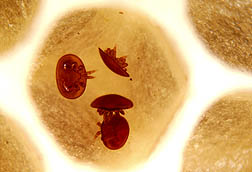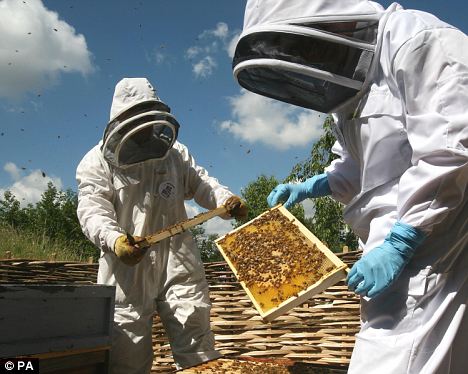U.S. Honey Bee Losses
The total number of managed honey bee colonies has decreased from 5 million in the 1940s to only 2.5 million today. At the same time, the call for hives to provide pollination services has continued to increase. This means honey bee colonies are being transported over longer distances than ever before.
 Declines in honey bee colony health were exacerbated in the 1980s with the arrival of new pathogens and pests. The arrival of Varroa and tracheal mites into the United States during the 1990s created additional stresses on honey bees.
Declines in honey bee colony health were exacerbated in the 1980s with the arrival of new pathogens and pests. The arrival of Varroa and tracheal mites into the United States during the 1990s created additional stresses on honey bees.
Colony losses from CCD are a very serious problem for beekeepers. Annual losses from the winter of 2006-2011 averaged about 33 percent each year, with a third of these losses attributed to CCD by beekeepers. The winter of 2011-2012 was an exception, when total losses dropped to 22 percent.
A 1-year drop is too short a time period to count as definitive improvement in honey bee colony survivorship. At least 2 to 3 years of consistently lower loss percentages is necessary before it is possible to be sure that CCD is on the decline.
The decrease in colony losses could be due to a number of different factors, among them:
- The 2011-2012 winter was unusually warm and could have contributed to higher colony survival rates, although there is no scientific research connecting warmer winter weather and CCD. January 2012 ranks as the fourth warmest January in U.S. history, according to NOAA.
- Research from ARS and other institutions has provided new management recommendations that beekeepers have begun to adopt. For example, it is now recommended that beekeepers feed honey bees more protein during times of nectar shortage such as during times of drought or in the winter. As part of this, ARS has developed a new bee diet, Megabee, now available to beekeepers. The feeding of supplemental nutrients may help to decrease winter colony losses.
- Some diseases are naturally cyclical, and CCD could be at the point where its cause/causes have passed their peak. Or it is possible that colonies that survive could be developing a natural resistance to overcome the unknown cause/causes of CCD. Unfortunately, there is no scientific proof for either of these at this time.
If losses continue at the 33 percent level, it could threaten the economic viability of the bee pollination industry. Honey bees would not disappear entirely, but the cost of honey bee pollination services would rise, and those increased costs would ultimately be passed on to consumers through higher food costs. Now is the time for research into the cause and treatment of CCD before CCD becomes an agricultural crisis.


